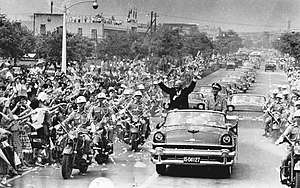Sino-American Mutual Defense Treaty
The Sino-American Mutual Defense Treaty, formally Mutual Defense Treaty between the United States of America and the Republic of China, was a defense pact between the United States of America and the Republic of China effective from 1955–1979. It essentially prevented the People's Republic of China from taking over the island of Taiwan in this time. Some of its content was carried over to the Taiwan Relations Act of 1979.
Long name:
| |
|---|---|
 Five years after the agreement is signed, U.S. President Dwight D. Eisenhower greets crowds in Taipei while on parade with Republic of China leader Chiang Kai-shek. | |
| Type | Defense Treaty |
| Location | Washington D.C. |
| Effective | March 3, 1955 |
| Expiry | December 31, 1979 |
| Parties | |
| Citations | 6 U.S.T. 433; T.I.A.S. No. 3178 |
| Languages | |
| Sino-American Mutual Defense Treaty | |||||||
|---|---|---|---|---|---|---|---|
| Traditional Chinese | 中美共同防禦條約 | ||||||
| Simplified Chinese | 中美共同防御条约 | ||||||
| |||||||
Background
In the context of Cold War and the confrontation between capitalism and communism worldwide, the Sino-American Mutual Defense Treaty between the United States of America and the Republic of China secured the island of Taiwan from invasion by the People's Republic of China in the aftermath of the Chinese Civil War on Mainland China.
Rather than taking a multilateral approach to their alliances and treaties in East Asia, as had been done in Europe with NATO, the U.S. decided on a bilateral approach with its Asian allies (Japan, South Korea and Taiwan), known as the San Francisco System or hubs-and-spokes system. Because the politics in Asia ranged from democratic to authoritarian, it would be difficult to find a base for multilateral relations stemming from shared values. Furthermore, the countries in Asia did not all face one common threat, unlike the West from the Soviet Union. It was therefore considered more beneficial to pursue bilateral relations.[1]
The treaty was signed on December 2, 1954, in Washington, D.C.[2] and came into force on March 3, 1955.[3]
The treaty prolonged and assisted the Republic of China in maintaining legitimacy as the sole government of the whole of mainland China until the early 1970s. During the Cold War, the treaty also helped US policymakers to shape the policy of containment in East Asia together with South Korea and Japan against the spread of communism.
Obligations and impact
.svg.png)
The treaty consists of ten main articles. The content of the treaty included the provision that if one country came under attack, the other would aid and provide military support.
The treaty was limited in application to the defense of the island of Taiwan and the Pescadores only. Kinmen and Matsu were not protected by this treaty. Therefore, the US stood aside during the Second Taiwan Strait Crisis. The treaty also discouraged the Republic of China from initiating any military action against mainland China, since only Taiwan and Pescadores were included and unilateral military actions not supported.
From the viewpoint of US Senate, in conjunction with the ratification of the MDT, a report issued Feb. 8, 1955, by the US Senate Committee on Foreign Relations specified: "It is the view of the committee that the coming into force of the present treaty will not modify or affect the existing legal status of Formosa and the Pescadores."
To avoid any possibility of misunderstanding on this aspect of the treaty, the committee decided it would be useful to include in this report the following statement:
It is the understanding of the Senate that nothing in the treaty shall be construed as affecting or modifying the legal status or sovereignty of the territories to which it applies.[4]
Termination
Article 10 of the treaty provided that either Party could terminate it one year after notice had been given to the other Party. Accordingly, the treaty came to an end on 1 January 1980, one year after the United States established diplomatic relations with the People's Republic of China on 1 January 1979.
The authority for President Jimmy Carter to unilaterally annul a treaty, in this case the Sino-American Mutual Defense Treaty, was the topic of the Supreme Court case Goldwater v. Carter in which the court declined to rule on the legality of this action on jurisdictional grounds, thereby allowing it to proceed.
Taiwan Relations Act
Shortly after the United States' recognition of the People's Republic of China, the U.S. Congress passed the Taiwan Relations Act. Some of the Sino-American Mutual Defense Treaty's content survives in the Act; for example the definition of "Taiwan". It falls short of promising Taiwan direct military assistance in case of an invasion, however.[5]
See also
- Battle of Kuningtou
- Political Status of Taiwan
- Taiwan Relations Act
- Taiwan Travel Act of 2018
References
- Cha, Victor D. (2010). "Powerplay: Origins of the U.S. Alliance in Asia". International Security. 34 (3 (Winter 2009/10)): 161–162. doi:10.1162/isec.2010.34.3.158.
- United States Department of State. Historical Office. Congress. Senate. Committee on Foreign Relations. (1957), American foreign policy. 1950–1955 basic documents., Washington: U.S. Govt. Print. Off., p. 945, OCLC 575035791,
DONE in duplicate, in the English and Chinese languages, at Washington on this second day of December of the Year One Thousand Nine Hundred and Fifty-four, corresponding to the second day of the twelfth month of the Forty-third year of the Republic of China.
- "Avalon Project - Mutual Defense Treaty Between the United States and the Republic of China; December 2, 1954". avalon.law.yale.edu. Archived from the original on March 10, 2012. Retrieved July 14, 2017.
- Appendix 17—Report on Mutual Defense Treaty with the Republic of China, U.S. Senate, Committee on Foreign Relations (1955) Archived October 18, 2017, at the Wayback Machine
- "American Institute in Taiwan – Taiwan Relations Act". Archived from the original on August 15, 2012. Retrieved August 10, 2012.